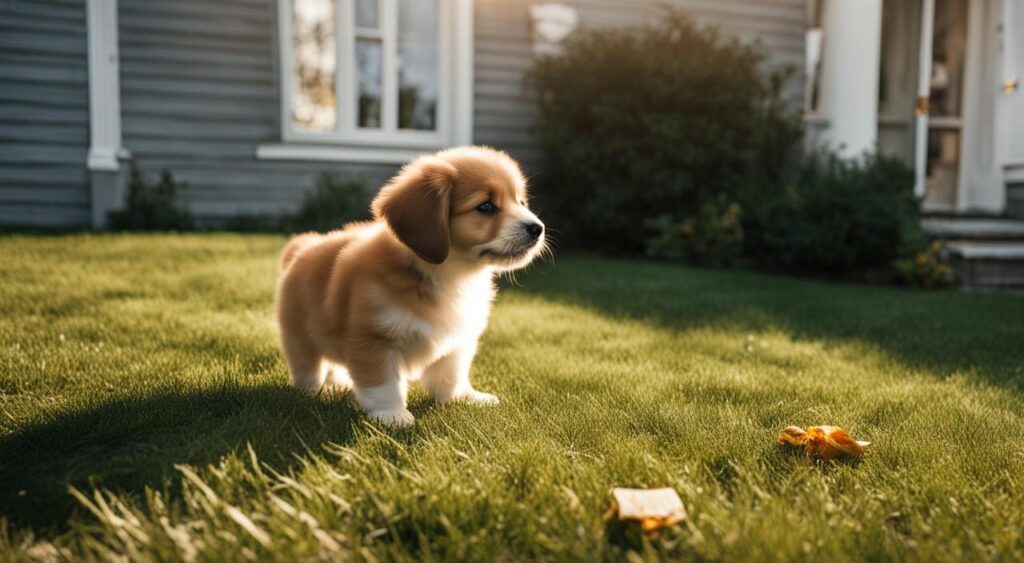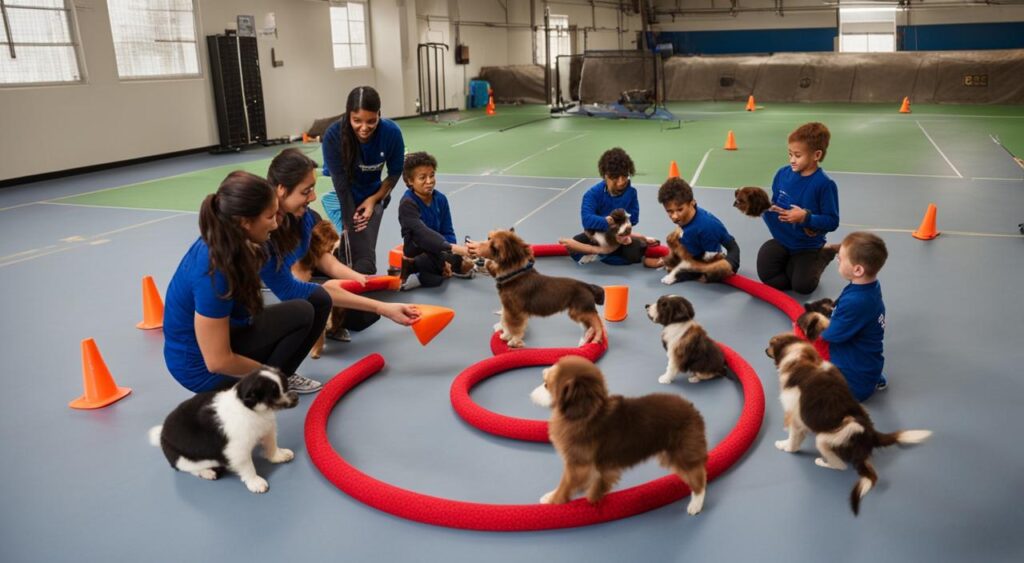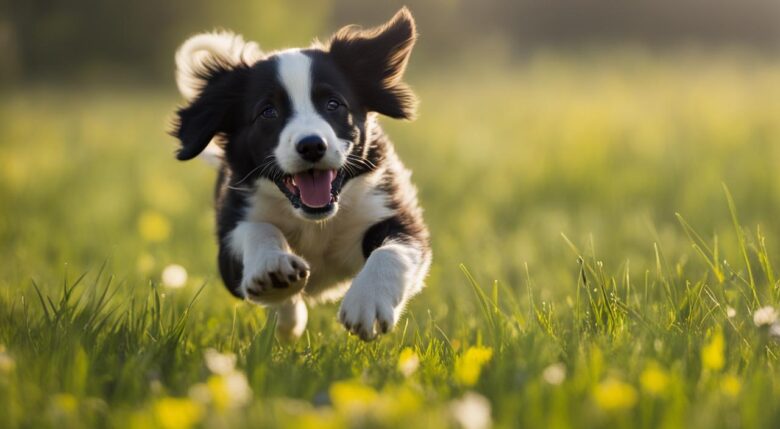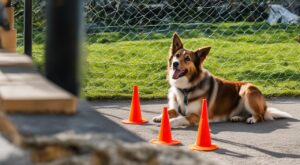Welcoming a new puppy into your home can be an exciting and rewarding experience. However, to ensure a well-behaved and happy furry friend, it is necessary to start with the fundamentals of puppy training. As a new dog owner, it is important to understand the basics of puppy training to establish a strong bond of trust and obedience between you and your puppy. In this section, we will provide essential puppy training tips to help you set the foundation for a fulfilling relationship with your new furry friend.
Key Takeaways:
- Consistency, patience, and positive reinforcement are key to successful puppy training.
- Understanding your puppy’s behavior and natural instincts is crucial before diving into training techniques.
- House training is essential for promoting cleanliness and comfort for both you and your pet.
- Enrolling in puppy training classes is a great option to improve your and your puppy’s training skills.
- Common challenges faced in puppy training, such as biting and chewing, can be overcome with practical tips and advice.
Understanding Puppy Behavior
Training a puppy can be a challenging undertaking, especially for first-time dog owners. Before jumping into training techniques, it’s crucial to understand the behavior of puppies. Here are some important things you should know:
Natural instincts: Puppies are naturally inquisitive and playful, but they also have instincts to chew, dig, and bark. These behaviors are normal and can be redirected to more appropriate activities through training.
Development stages: Puppies go through several developmental stages, such as socialization, fear imprinting, and adolescence. Each stage comes with its own challenges and requirements for training. Understanding these stages can help you provide the right training at the right time.
Common behaviors: Puppies exhibit various behaviors, including biting, jumping, and pulling on the leash. These behaviors can be frustrating but are also opportunities for training. By learning to communicate with your puppy effectively, you can teach them to exhibit appropriate behaviors.
To effectively train your new furry friend, consider enrolling in puppy behavior training or puppy obedience training classes. These classes provide a structured environment for you and your pup to learn and practice essential training skills.
House Training Your Puppy
House training is a critical part of owning a puppy. Not only does it promote cleanliness and comfort for you and your pet, but proper house training can also prevent behavioral problems from developing in the future. Below are some proven methods and strategies for teaching your puppy appropriate bathroom behavior and establishing a routine.
Create a Schedule
Create a schedule for feeding your puppy and taking them outside for bathroom breaks. Puppy bladders are small, which means they need frequent trips outdoors to relieve themselves. Take your puppy out every few hours, and don’t forget to go after meals, playtime, and waking up in the morning. Consistency is key to successful house training.
Choose a Spot
Choose a specific spot outside for your puppy to relieve themselves. This will help them associate that spot with going to the bathroom. Use a command, such as “go potty” or “do your business,” when you take your puppy to their spot. Over time, your puppy will learn to go on command.
Reward Good Behavior
When your puppy goes to the bathroom outside, be sure to reward them with praise and treats. Positive reinforcement is an effective training method that encourages desirable behavior. Your puppy will associate going outside with rewards, which will motivate them to repeat good behavior.

Indoor Accidents
Even with the best efforts, indoor accidents are bound to happen during the house training process. When accidents occur, resist the urge to scold or punish your puppy. Instead, interrupt them with a firm “no,” and immediately take them outside to their designated spot. Clean up the mess thoroughly with an enzymatic cleaner to eliminate any odors that might attract your puppy back to the same spot.
Remember, patience and consistency are essential when it comes to house training a puppy. Use positive reinforcement, establish a routine, and reward good behavior to set your puppy up for success.
Positive Reinforcement Training Techniques
If you’re looking for the best puppy training techniques, positive reinforcement is a tried-and-true method that helps you establish a strong bond with your furry friend. Positive reinforcement focuses on encouraging good behavior by rewarding it with treats, praise, or playtime rather than punishing bad behavior. This not only motivates your puppy but also enhances their learning experience.
One popular positive reinforcement technique is clicker training, which involves using a small device that makes a clicking sound to signal when your puppy has done something right. When you click, you immediately follow it with a treat or verbal praise to reinforce the good behavior. This way, your puppy quickly learns to associate the click with positive reinforcement and will be eager to repeat the behavior.
Another effective positive reinforcement method is treat rewards. Simply reward your puppy with a small treat when they display good behavior, such as successfully completing a command. However, be sure to use treats in moderation to avoid overfeeding your puppy.
Remember to always use immediate positive reinforcement and avoid rewarding bad behavior. Consistency is key to successful positive training.
“Training a puppy is like molding clay – every interaction shapes their behavior. Positive reinforcement is a gentle and effective way to shape that clay into a well-behaved and happy dog.”
Enrolling in Puppy Training Classes

While some pet owners opt to train their puppies themselves, others find it beneficial to enroll in puppy training classes. These classes provide a structured environment for both you and your puppy to learn and practice essential training skills.
Not only do puppy training classes teach basic obedience commands, but they also help socialize your puppy with other dogs and people, which is crucial for their development. Plus, they offer a chance for you to interact with other dog owners who may be facing similar challenges.
When choosing a puppy training class, it’s important to research and find one that suits your needs. Consider factors such as class size, training methods, instructor experience, and location. Look for classes that use positive reinforcement techniques, as these are the most effective and humane methods for puppy training.
By enrolling in puppy training classes, you can ensure that your puppy receives the training and socialization they need to become a well-behaved and happy companion. So why wait? Sign up for a class today!
Solving Common Puppy Training Challenges
Bringing a new puppy home can be an exciting time, but it can also be challenging. New dog owners may face issues such as biting, chewing, leash pulling, and separation anxiety. Here are some practical puppy training advice to help you overcome these common challenges:
Biting
Biting is a natural behavior for puppies as they explore the world around them. However, it’s important to train your puppy to control the pressure of their bite and to redirect their behavior onto an appropriate chew toy. Using positive reinforcement techniques, such as reward-based training, can help modify biting behavior.
Chewing
Puppies naturally chew to relieve teething pain or boredom. To prevent destructive chewing, provide your puppy with plenty of chew toys and supervise them when playing. Redirect your puppy’s behavior to an appropriate chew toy when they start chewing on inappropriate items. Consistency is key to promoting good chewing behavior.
Leash Pulling
Leash pulling can be frustrating for new dog owners. Start training your puppy with a properly fitting collar or harness and a standard flat leash. Teach your puppy to walk calmly on a leash by using positive reinforcement training, such as rewarding their good behavior with treats. Training sessions should be short and consistent to reinforce desired leash behavior.
Separation Anxiety
Separation anxiety, or the distress a puppy feels when left alone, can be challenging for new owners. Gradually acclimate your puppy to being alone by starting with short periods and gradually increasing the time. Provide your puppy with toys and treats to keep them satisfied while you’re away. Consider enrolling in puppy training classes to learn techniques to reduce separation anxiety.
“Puppy training can be challenging, but the effort is worth it to establish a happy and well-behaved pet.”
Conclusion
Effective dog training requires patience, consistency, and positive reinforcement. By following the tips and techniques outlined in this article, new dog owners can lay the foundation for a well-behaved and happy furry friend.
Remember to take the time to understand your puppy’s behavior and establish a routine that promotes good habits. Enrolling in puppy training classes can also provide structure and guidance for both you and your pet.
While training a puppy can come with challenges, such as biting, chewing, and leash pulling, these issues can be overcome with practical advice and strategies.
Whether you are a new dog owner or a seasoned pet parent, continuing education and consistent training are key to maintaining a well-trained and happy dog. Start your puppy training journey today!
Thank you for reading our article on puppy training tips for new dog owners. We hope you found it informative and helpful in your dog training journey.
FAQ
What are some essential tips for new dog owners starting puppy training?
New dog owners should start puppy training by establishing a routine, setting clear rules and boundaries, and using positive reinforcement techniques. Consistency, patience, and regular exercise are also crucial for successful training.
How can I understand and manage my puppy’s behavior?
Understanding puppy behavior involves learning about their natural instincts and development stages. Watching for signs of teething, socialization needs, and addressing common behaviors like chewing and biting can help effectively manage and redirect your puppy’s behavior.
What are the best methods for house training a puppy?
House training your puppy requires consistency and positive reinforcement. Establish a regular bathroom schedule, provide frequent potty breaks, reward desired behavior, and clean up accidents properly to reinforce the desired habit of going outside.
How does positive reinforcement training contribute to successful puppy training?
Positive reinforcement training focuses on rewarding desired behaviors rather than punishing unwanted ones. Techniques like clicker training and treat rewards can motivate your puppy and strengthen the bond between you and your pet.
Should I enroll my puppy in training classes?
Puppy training classes offer a structured environment for both you and your puppy to learn and practice essential training skills. Classes provide professional guidance, socialization opportunities, and a chance to address specific behavioral challenges.
How can I overcome common challenges in puppy training?
Common challenges in puppy training include biting, chewing, leash pulling, and separation anxiety. Redirecting biting and chewing behaviors, teaching loose leash walking techniques, and gradually desensitizing your puppy to being alone can help overcome these challenges.
Why is consistency, patience, and positive reinforcement important in puppy training?
Consistency helps puppies understand and adhere to the rules. Patience allows time for your puppy to learn and adjust. Positive reinforcement reinforces desired behaviors and builds a positive association with training, making it more enjoyable for both you and your puppy.
What can I do to ensure successful puppy training?
Successful puppy training starts with educating yourself about puppy behavior, establishing a routine, using positive reinforcement techniques, and seeking professional guidance when needed. Remember to be patient, consistent, and to enjoy the journey of training your new furry friend.




